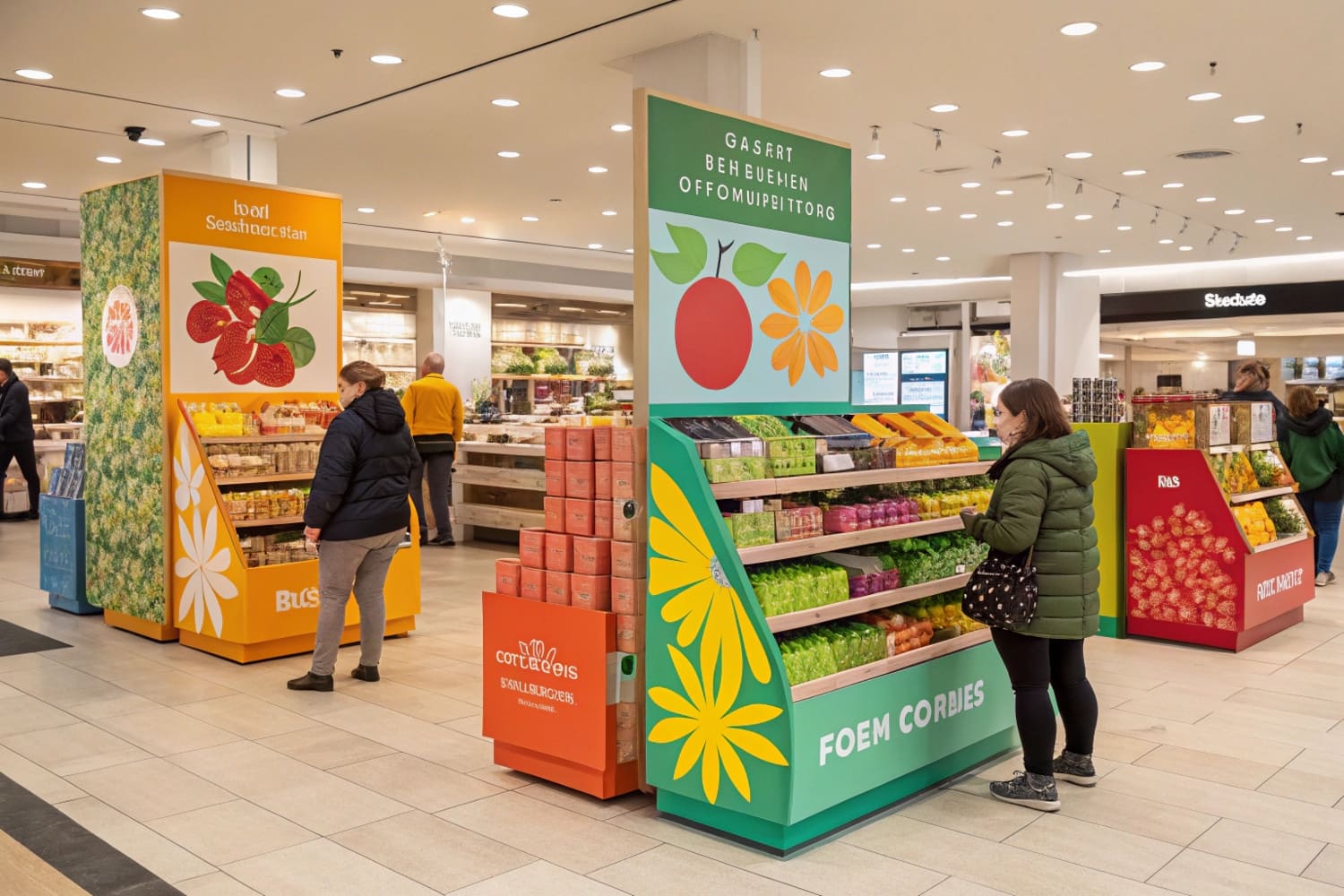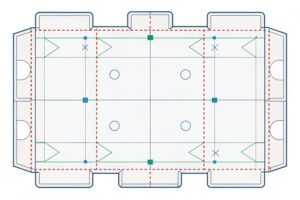जब डिस्प्ले पुराने लगने लगते हैं तो बिक्री धीमी हो जाती है। खरीदार पास से गुज़र जाते हैं। इन्वेंट्री खाली पड़ी रहती है। मैंने ऐसा कई बार देखा है। इसलिए मैं रिफ्रेश चक्रों के लिए स्पष्ट नियमों का इस्तेमाल करता हूँ जिससे उत्पाद चलते रहें।
हर 4-8 हफ़्ते में छोटे-छोटे साप्ताहिक अपडेट के साथ, मौसमी डिस्प्ले को ताज़ा करें। अगर बिक्री कम हो, ट्रैफ़िक में बदलाव हो, मौसम में बदलाव हो, या फिक्स्चर खराब हो जाएँ, तो पहले ही बदलाव करें। प्रमुख रीसेट को छुट्टियों, उत्पाद लॉन्च और स्थानीय आयोजनों के साथ संरेखित करें।
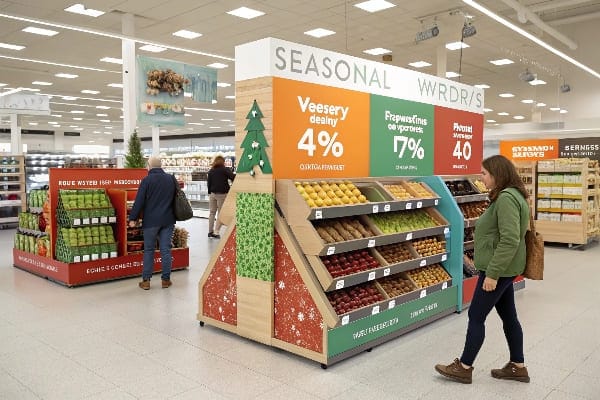
मैं आपको सरल टाइमिंग नियम, वास्तविक ट्रिगर्स और तेज़ी से रिफ्रेश करने के कम खर्चीले तरीके बताऊँगा। मैं एक छोटी-सी फ़ैक्टरी की कहानी भी बताऊँगा, ताकि आप देख सकें कि मैदान में क्या कारगर है।
कितनी बार डिस्प्ले को बदला जाना चाहिए?
धीमे हफ़्ते भी आते हैं। कर्मचारी व्यस्त रहते हैं। प्रदर्शनियाँ एक जैसी ही रहती हैं। मुझे भी उस दबाव का सामना करना पड़ता है। एक निश्चित लय टीम को योजना बनाने, सामग्री खरीदने और बिक्री को सुरक्षित रखने में मदद करती है।
अधिकांश श्रेणियों में प्रत्येक 6-8 सप्ताह में मुख्य मौसमी डिस्प्ले बदलें, फास्ट-टर्न आइटम में प्रत्येक 4-6 सप्ताह में बदलें, और पूर्ण पुनर्निर्माण के बिना लेआउट को ताजा रखने के लिए साप्ताहिक रूप से माइक्रो-अपडेट करें।
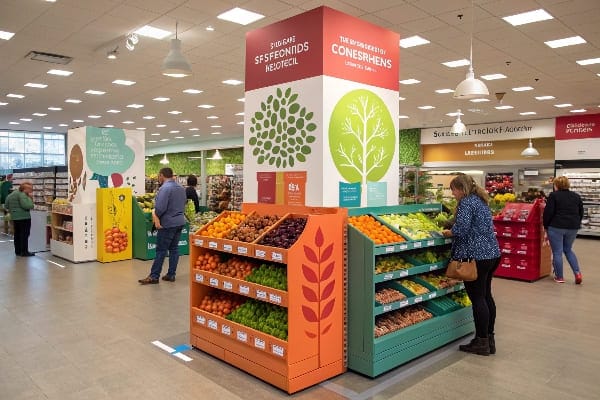
व्यावहारिक ताल और ट्रिगर
मैं दो-स्तरीय योजना का उपयोग करता हूँ। पहला, मैं एक बेस रिफ्रेश विंडो लॉक करता हूँ। दूसरा, मैं हर हफ्ते साधारण संख्याओं पर नज़र रखता हूँ। अगर सेल-थ्रू 1 लक्ष्य से नीचे चला जाता है, तो मैं अगले रीसेट को आगे बढ़ा देता हूँ। मैं फिक्स्चर के घिसाव, कीमतों में बदलाव और मौसम में बदलाव को भी स्कैन करता हूँ। कार्डबोर्ड के लिए, छोटे-छोटे स्वैप लागत कम रखते हैं। हेडर बदलें, एक नया ट्रे जोड़ें, या हीरो SKU को पलटें। मेरी फैक्ट्री तीन लाइनें चलाती है, इसलिए हम कुछ ही दिनों में नए हेडर काटते हैं। हम मज़बूती की जाँच करते हैं, फिर कम माल ढुलाई के लिए फ्लैट शिप करते हैं। इससे खरीदार सिर्फ़ बात करने के बजाय, तेज़ी से रिफ्रेश कर पाते हैं।
| श्रेणी (उदाहरण) | आधार ताज़ा | साप्ताहिक सूक्ष्म-अपडेट | पहले चलने के लिए ट्रिगर |
|---|---|---|---|
| एफएमसीजी स्नैक्स | 6-8 सप्ताह | फेसिंग, मूल्य कार्ड | सप्ताह-दर-सप्ताह बिक्री में 15% की गिरावट |
| प्रसाधन सामग्री | 4-6 सप्ताह | परीक्षक स्वच्छता, हीरो छाया | नया लॉन्च या प्रभावशाली लोगों की संख्या में वृद्धि |
| इलेक्ट्रॉनिक्स सहायक उपकरण | 6-8 सप्ताह | केबल ऑर्डर, हुक | वापसी या क्षति >2% |
| खिलौने और खेल | 4-6 सप्ताह | डेमो स्वैप, छोटे प्रॉप्स | स्कूल की छुट्टी या स्थानीय कार्यक्रम |
बहुत लंबे समय तक प्रतीक्षा करने के जोखिम
अगर मैं इंतज़ार करता हूँ, तो मुझे धूल, मुड़ी हुई अलमारियाँ और फीके प्रिंट दिखाई देते हैं। दुकानदारों को लगता है कि उत्पाद पुराना हो गया है। कर्मचारी आना बंद कर देते हैं। कीमतों के लेबल बदल जाते हैं। एक बार छूट जाने पर रीफ़्रेश करने से भी ज़्यादा खर्चा हो सकता है। हफ़्ते में एक छोटी सी आदत बाद में पूरी तरह से दोबारा बनाने की तकलीफ़ से बचाती है।
विंडो डिस्प्ले कितनी बार बदले जाते हैं?
विंडोज़ एक शब्द कहे जाने से पहले ही ब्रांड का पता लगा लेती है। लोग कुछ ही सेकंड में फ़ैसला कर लेते हैं। अगर विंडो अटकी हुई दिखती है, तो वे मान लेते हैं कि दुकान भी अटकी हुई है। मैं विंडोज़ को मीडिया की तरह मानता हूँ।
ज़्यादातर दुकानों के लिए हर 4 हफ़्ते में, ज़्यादा ट्रैफ़िक वाली सड़कों पर हर 2-3 हफ़्ते में, और प्रमुख छुट्टियों या लॉन्च के लिए 72 घंटों के अंदर विंडो डिस्प्ले बदलें। छोटी चीज़ों को हर हफ़्ते अपडेट करें।
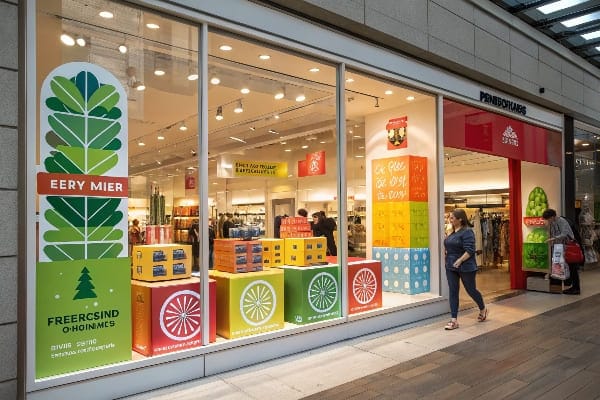
स्थान और पैदल यात्रियों की संख्या के अनुसार ताल का मिलान करें
खिड़की की लय इस बात पर निर्भर करती है कि कौन और कितनी बार वहाँ से गुज़रता है। व्यस्त सड़क पर लगे फ़्लैगशिप को उपनगरीय स्ट्रिप लोकेशन की तुलना में तेज़ी से बदलना पड़ता है। मौसम भी मायने रखता है। सूरज प्रिंट को फीका कर देता है। मैं यूवी-स्थिर स्याही का इस्तेमाल करता हूँ और खुले हुए हेडर को जल्दी बदल देता हूँ। एक शिकार के मौसम के प्रोजेक्ट के लिए, हमारे क्लाइंट डेविड को तीन विंडो वेव्स की ज़रूरत थी: आर्चरी ओपनर, पीक रट, और लेट सीज़न। हमने पहले से ही दिनांकित किट पैक कर रखी थीं। हमने अतिरिक्त डेकल्स भी शामिल किए क्योंकि ठंडे कांच से बुलबुले बन सकते हैं। इस छोटी सी बात ने आपातकालीन कॉल से बचा लिया।
| संग्रह प्रकार | विशिष्ट ताल | साप्ताहिक संपर्क बिंदु | नोट |
|---|---|---|---|
| फ्लैगशिप स्ट्रीट | 2–3 सप्ताह | साफ कांच, हल्का निशाना | पेड मीडिया के रूप में व्यवहार करें |
| मॉल इनलाइन | 3-4 सप्ताह | पुतला मुद्रा, संकेत ट्वीक | मॉल प्रोमो के साथ संरेखित करें |
| स्ट्रिप सेंटर | 4 सप्ताह | डोर डीकल रिफ्रेश | मौसमरोधी सामग्री |
| विशेष आउटडोर | 3-4 सप्ताह | ट्रॉफी प्रॉप स्वैप | स्थानीय मौसमों के साथ समन्वयित करें |
विंडोज़ के संचालन के लिए सुझाव
मैं विंडो किट को मॉड्यूलर रखता हूँ। मैं लेयर्ड पीस प्रिंट करता हूँ, ताकि कर्मचारी बिना किसी सीढ़ी या लंबे समय तक काम बंद किए हेडर या प्रॉप बदल सकें। मैं क्यूआर कोड आँखों के स्तर पर लगाता हूँ, कभी भी बहुत नीचे नहीं। मैं दरवाज़े के झूलों के पास व्यस्त कलाकृतियाँ लगाने से बचता हूँ। मैं हर पीस पर एक हफ़्ते का नंबर लगाता हूँ, ताकि बदलाव की योजना आसान हो।
मौसमी प्रदर्शन क्या है?
मौसमी प्रदर्शन समय और संदर्भ का उपयोग करके उत्पादों को वर्तमान का एहसास दिलाता है। यह मौसम, छुट्टियों, स्थानीय आयोजनों और आदतों को दर्शाता है। यह मूड, कीमत और ज़रूरत को जोड़ता है।
मौसमी प्रदर्शन एक समयबद्ध व्यापारिक व्यवस्था है जो उत्पादों को समयबद्ध विषय से जोड़ती है, केंद्रित कहानी का उपयोग करती है, तथा प्रासंगिकता और बिक्री को उच्च बनाए रखने के लिए योजनाबद्ध ताल पर परिवर्तन करती है।
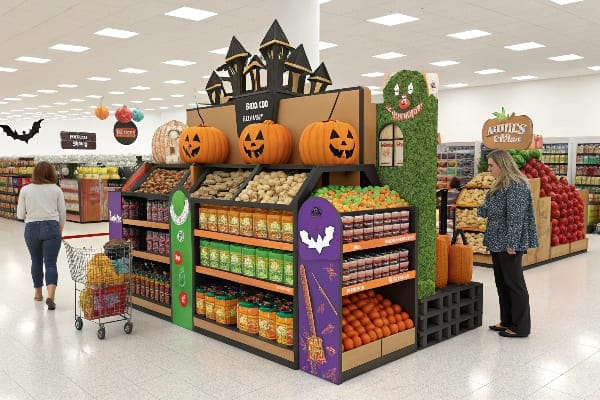
मुख्य तत्व जो इसे कारगर बनाते हैं
एक मज़बूत सीज़नल डिस्प्ले 2 के पाँच हिस्से होते हैं। पहला, एक स्पष्ट थीम। दूसरा, एक हीरो प्रोडक्ट 3 या बंडल। तीसरा, आँखों के लिए एक आसान रास्ता। चौथा, अभी खरीदने का एक कारण। पाँचवाँ, एक रिफ्रेश प्लान। कार्डबोर्ड में, यह आसान है। मैंने एक बोल्ड हेडर, दो शेल्फ़, एक साइड पैनल स्टोरी और एक प्राइस स्ट्रिप काटी। मैं एक छोटे वीडियो में ट्राई-मी ट्रे या एक क्यूआर कोड भी जोड़ सकता हूँ। मेरी टीम तेज़ी से प्रोटोटाइप बनाती है, फिर हम मज़बूती और परिवहन परीक्षण करते हैं, क्योंकि एक ढीली शेल्फ़ से ज़्यादा भरोसा कोई नहीं तोड़ती। जब खरीदार माँगते हैं तो हम पानी आधारित स्याही और प्रमाणित बोर्ड का इस्तेमाल करते हैं। इससे लुक साफ़ रहता है और कागज़ात तैयार रहते हैं।
| तत्व | उद्देश्य | कार्डबोर्ड में उदाहरण |
|---|---|---|
| विषय | मूड सेट करें | “अर्ली सीज़न बो प्रेप” पैलेट और आइकन |
| नायक | ध्यान केन्द्रित करना | दो प्रमुख SKU के साथ एक प्रमुख धनुष |
| पथ | गाइड स्कैनिंग | शीर्ष हेडर → हीरो → ऐड-ऑन हुक |
| तात्कालिकता | अभी कार्रवाई करें | सीमित छूट 31 अक्टूबर को समाप्त होगी |
| योजना | प्रासंगिकता बनाए रखें | सप्ताह 4 में हेडर स्वैप |
चुनने के लिए प्रारूप
मैं ट्रैफ़िक और बास्केट के आकार के आधार पर फ़ॉर्म चुनता हूँ। जब मुझे प्रभाव की ज़रूरत होती है, तो फ़्लोर डिस्प्ले बेहतर विकल्प होते हैं। काउंटर यूनिट चेकआउट के पास ऐड-ऑन के लिए काम करते हैं। पैलेट डिस्प्ले क्लब स्टोर्स पर राज करते हैं। शेल्फ ट्रे गति और प्लानोग्राम फ़िटनेस के लिए बेहतर हैं। मैं मॉड्यूलर रहता हूँ, इसलिए एक प्रिंट किट छोटे बदलावों के साथ दो या तीन सेटअप को सपोर्ट करती है।
मौसमी बिक्री को बढ़ावा देने के लिए विजुअल मर्चेंडाइजिंग डिस्प्ले का उपयोग कैसे किया जा सकता है?
लोग तब खरीदते हैं जब प्रदर्शन से संदेह दूर हो जाता है। वे तब खरीदते हैं जब यह समय पर लगता है। वे तब खरीदते हैं जब कीमत और पैकेज उचित लगते हैं। मेरा काम इन बिंदुओं को एक साथ लाना है।
मौसमी समस्या को स्पष्ट समाधान से जोड़ने के लिए डिस्प्ले का उपयोग करें, हीरो और ऐड-ऑन को एक साथ दिखाएं, तात्कालिकता जोड़ें, और उत्पाद के करीब सरल परीक्षण, डेमो या सामाजिक प्रमाण के साथ मूल्य साबित करें।
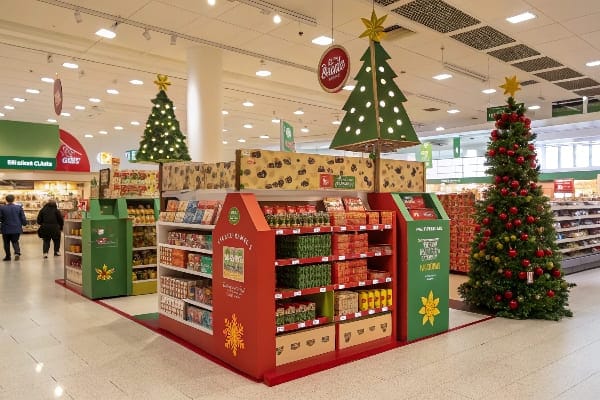
एक सरल कार्यपुस्तिका जो काम करती है
मैं प्लान-डू-लर्न लूप 4 । कहानी और बंडल की योजना बनाएं। प्रोटोटाइप बनाएं, फिर एक त्वरित स्टोर परीक्षण करें। बिक्री और दुकानदारों की प्रतिक्रिया से सीखें। फिर मैं छोटे सुधारों के साथ स्केल करता हूं। डेविड के फॉल लॉन्च के लिए, हमने एक क्रॉसबो हीरो 5 को ब्रॉडहेड्स, वैक्स और एक कॉम्पैक्ट टारगेट के साथ जोड़ा। हमने बंडल को एक फ्लोर यूनिट पर रखा। हमने साइड पैनल पर एक छोटा सेटअप गाइड प्रिंट किया। हमने 30 सेकंड की क्लिप में एक क्यूआर कोड जोड़ा। हमने सुरक्षा चिंताओं को दूर करने के लिए शेल्फ पर एक छोटा सा स्ट्रेंथ बैज रखा। हमने पहले सप्ताह के लिए रोजाना सेल-थ्रू को ट्रैक किया। जब हमने ग्रामीण दुकानों में तेज आवाजाही देखी, तो हमने वहां दूसरी लहर को आगे बढ़ाया। हमने तीसरे दिन के बाद हेडर को उज्जवल बनाया क्योंकि गलियारे की रोशनी गर्म थी और कला को धुंधला कर रही थी।
| रणनीति | निष्पादन प्रदर्शित करें | यह क्यों मदद करता है? | देखने योग्य KPI |
|---|---|---|---|
| समस्या → समाधान | एक इकाई पर "ठंड के मौसम की तैयारी किट" बंडल | तेज़ तर्क | संलग्न दर |
| तात्कालिकता | मूल्य पट्टी पर तारीख, सीमित बोनस | अभी कार्रवाई करें | सप्ताह-दर-सप्ताह बिक्री |
| सबूत | “फ़ील्ड-परीक्षणित” आइकन 6 , UGC QR | जल्दी भरोसा करो | निवास का समय |
| मुझे आजमाओ | सुरक्षित डेमो या नमूना | संदेह दूर करता है | परिवर्तन |
| पार बेचने | हीरो के पास ऐड-ऑन हुक | बड़ी टोकरी | प्रति टिकट इकाइयाँ |
| डिजिटल ब्रिज | क्यूआर से लघु वीडियो 7 , एआर प्रयास | स्पष्टता, मज़ा | स्कैन-टू-बाय दर |
इसे निष्पादित करना आसान बनाएं
अच्छे विचार मर जाते हैं अगर दुकानें उन्हें बना न सकें। मैं ऐसे पुर्जे डिज़ाइन करता हूँ जो एक बार मुड़ जाते हैं, बिना औज़ारों के लॉक हो जाते हैं, और सीधे भेजे जाते हैं। मैं हर टुकड़े पर स्पष्ट संख्याएँ छापता हूँ। मैं एक पृष्ठ का निर्माण मानचित्र भी शामिल करता हूँ। मैं ट्रे के आकार को मानकीकृत करता हूँ ताकि पुनःपूर्ति आसान हो। मैं एक साधारण नमूने से प्रिंटों का रंग-परीक्षण करता हूँ जो अंतिम बोर्ड की प्रतिकृति बनाता है, ताकि बड़े पैमाने पर किया गया उत्पादन स्वीकृत नमूने से मेल खाए। इससे "नमूना अलग दिख रहा था" जैसी तकलीफ़देह शिकायत से बचा जा सकता है। जब विनिर्देश अनुमति देते हैं, तो मैं पुनर्चक्रित बोर्ड का उपयोग करता हूँ, और मैं किट में प्रमाणन भी शामिल करता हूँ। खरीदार परवाह करते हैं, और इससे अनुमोदन में तेज़ी आती है।
निष्कर्ष
एक बेस कैडेंस सेट करें, सरल ट्रिगर्स देखें, और छोटे-छोटे चरणों में रिफ्रेश करें। डिस्प्ले को मॉड्यूलर, ईमानदार और समयबद्ध रखें। छोटे-छोटे साप्ताहिक मूव्स हर बार दुर्लभ, बड़े रीसेट्स को मात देते हैं।
इन्वेंट्री को अनुकूलित करने और यह सुनिश्चित करने के लिए कि उत्पाद कुशलतापूर्वक आगे बढ़ रहे हैं, सेल-थ्रू को समझना महत्वपूर्ण है। ↩
मौसमी प्रदर्शन के मूल तत्वों को समझने से आपकी विपणन रणनीतियों में सुधार हो सकता है और बिक्री में वृद्धि हो सकती है। ↩
ग्राहकों को आकर्षित करने और बिक्री बढ़ाने के लिए सही हीरो उत्पाद का चयन करना महत्वपूर्ण है; इस विषय पर विशेषज्ञों की राय जानें। ↩
योजना-कार्य-सीखें चक्र को समझने से आपकी उत्पाद विकास रणनीति में सुधार हो सकता है और परिणाम बेहतर हो सकते हैं। ↩
अपने शिकार के अनुभव को अनुकूलित करने के लिए शीर्ष क्रॉसबो सहायक उपकरण का अन्वेषण करें और सुनिश्चित करें कि आपके पास सबसे अच्छा गियर है। ↩
जानें कि 'फील्ड-टेस्टेड' आइकन किस प्रकार विश्वास पैदा करता है और विपणन में उपभोक्ता के निर्णयों को प्रभावित करता है। ↩
ग्राहकों को आकर्षित करने और खुदरा क्षेत्र में बिक्री बढ़ाने के लिए क्यूआर कोड का उपयोग करने की प्रभावी रणनीतियों की खोज करें। ↩

